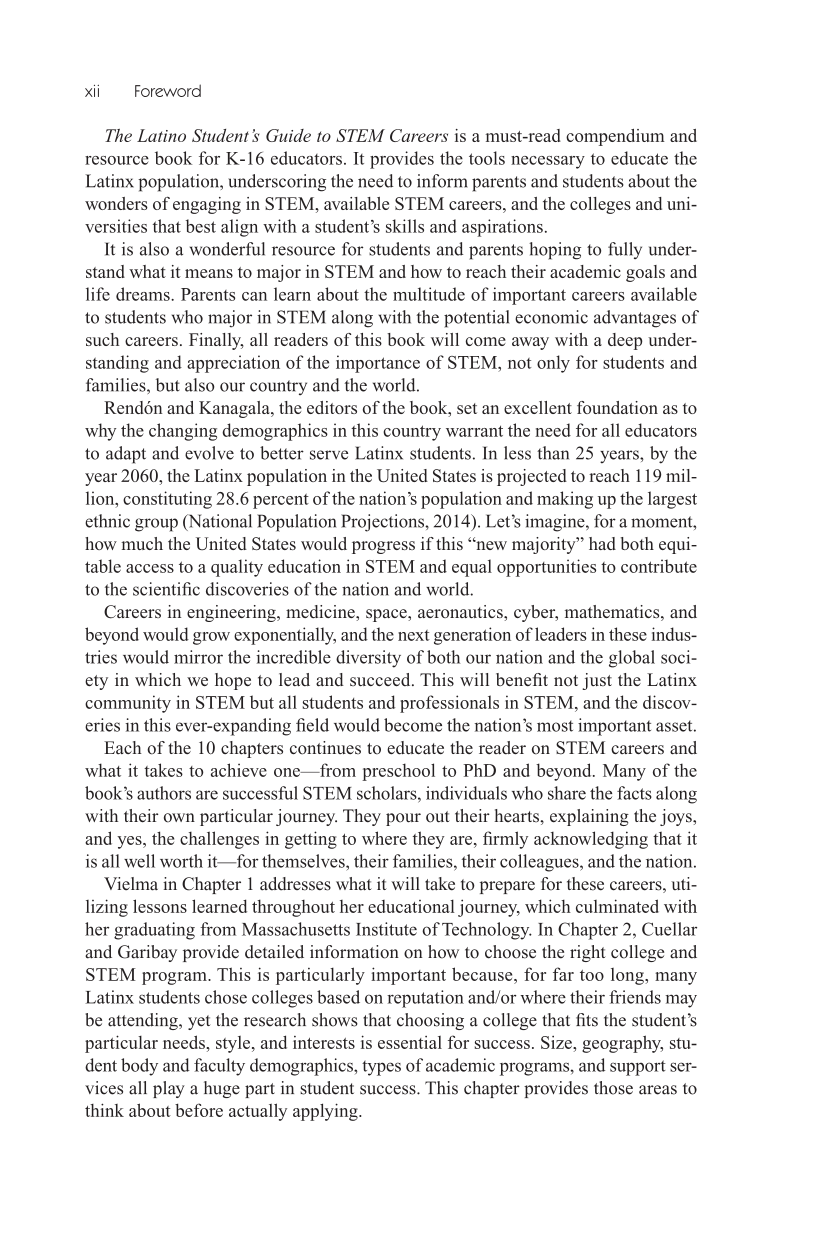xii Foreword
The Latino Student’s Guide to STEM Careers is a must-read compendium and
resource book for K-16 educators. It provides the tools necessary to educate the
Latinx population, underscoring the need to inform parents and students about the
wonders of engaging in STEM, available STEM careers, and the colleges and uni-
versities that best align with a student’s skills and aspirations.
It is also a wonderful resource for students and parents hoping to fully under-
stand what it means to major in STEM and how to reach their academic goals and
life dreams. Parents can learn about the multitude of important careers available
to students who major in STEM along with the potential economic advantages of
such careers. Finally, all readers of this book will come away with a deep under-
standing and appreciation of the importance of STEM, not only for students and
families, but also our country and the world.
Rendón and Kanagala, the editors of the book, set an excellent foundation as to
why the changing demographics in this country warrant the need for all educators
to adapt and evolve to better serve Latinx students. In less than 25 years, by the
year 2060, the Latinx population in the United States is projected to reach 119 mil-
lion, constituting 28.6 percent of the nation’s population and making up the largest
ethnic group (National Population Projections, 2014). Let’s imagine, for a moment,
how much the United States would progress if this “new majority” had both equi-
table access to a quality education in STEM and equal opportunities to contribute
to scientific discoveries of the nation and world. the
Careers in engineering, medicine, space, aeronautics, cyber, mathematics, and
beyond would grow exponentially, and the next generation of leaders in these indus-
tries would mirror the incredible diversity of both our nation and the global soci-
ety in which we hope to lead and succeed. This will benefit not just the Latinx
community in STEM but all students and professionals in STEM, and the discov-
eries in this ever-expanding field would become the nation’s most important asset.
Each of the 10 chapters continues to educate the reader on STEM careers and
what it takes to achieve one—from preschool to PhD and beyond. Many of the
book’s authors are successful STEM scholars, individuals who share the facts along
with their own particular journey. They pour out their hearts, explaining the joys,
and yes, the challenges in getting to where they are, firmly acknowledging that it
is all well worth it—for themselves, their families, their colleagues, and the nation.
Vielma in Chapter 1 addresses what it will take to prepare for these careers, uti-
lizing lessons learned throughout her educational journey, which culminated with
her graduating from Massachusetts Institute of Technology. In Chapter 2, Cuellar
and Garibay provide detailed information on how to choose the right college and
STEM program. This is particularly important because, for far too long, many
Latinx students chose colleges based on reputation and/or where their friends may
be attending, yet the research shows that choosing a college that fits the student’s
particular needs, style, and interests is essential for success. Size, geography, stu-
dent body and faculty demographics, types of academic programs, and support ser
vices all play a huge part in student success. This chapter provides those areas to
think about before actually applying.









































































































































































































































































































